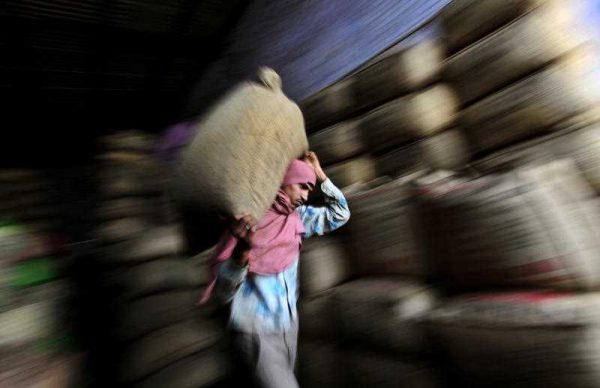Trade is low and limited because the trade regimes of each country are closed to each other.
Bilateral trade between Pakistan and India has always faced a series of tariff and non-tariff barriers, that are a consequence of the political tensions between the two countries.
Neither Pakistan nor India are generally open economies. They have among the most restrictive trade regimes worldwide. The Trade Tariff Restrictiveness Index (TTRI) shows that average tariff rates are higher in Pakistan and India than for most other regions. There has also been no significant improvement in either country’s logistics performance index over the last eight years. Bilateral trade is constrained by poor infrastructure, both soft and physical.
There is huge potential to expand bilateral trade. The Pakistan and Indian economies are highly complementary, and are becoming more so over time. The two countries also share a common border, history and cultural similarities. Yet, despite this, trade ties between the two largest economies in South Asia remain weak.
Both countries have made moves towards improving economic relations. In 1995, India granted most favoured nation (MFN) status to Pakistan, but Pakistan did not reciprocate. Pakistan decided to extend MFN status to India in 2011, with an aim for this to become effective from 1 January 2013, but this target was missed. The South Asia Free Trade Area (SAFTA) has likewise failed to live up to expectations. In 2004 the two countries signed the agreement, along with six other South Asian nations, but there has been no substantial improvement in the trading environment and no increase in bilateral trade .
So what are the underlying factors restricting trade between the two countries? And why have attempts to increase trade, including SAFTA, been ineffective?
In our recent paper, Pakistan–India Trade and MFN, we argue that institutional and non-institutional arrangements are crucial in explaining the ineffectiveness of trade reforms, including SAFTA, in boosting bilateral trade.
Pakistan’s trade should be directly related to the economic size of its partner countries and inversely related to the distance between them. Contrary to standard economic theory, the common border has a negative and significant impact on Pakistan’s bilateral trade in the region. Common borders are a barrier to not a facilitator of trade with Pakistan. Trade with the only two countries that share a common border with Pakistan, India and Afghanistan is limited because of political conflicts, institutional hurdles and procedural restrictions. And much of the border trade between Pakistan and Afghanistan, and Pakistan and India, is underground and unrecorded.
SAFTA and MFN have had a positive but insignificant effects on Pakistan’s bilateral trade. Regional and bilateral trade agreements are not the only answer to enhancing Pakistan’s bilateral trade.
How can Pakistan reap the benefits of trade agreements? Tariff and non-tariff barriers are a major constraint in expanding bilateral trade in the region and have a significant negative impact on the Pakistan’s bilateral trade in the region. Yet the region as a whole has failed to reduce tariff rates and eliminate non-tariff barriers. Merely signing an agreement has no impact on trade. Concrete steps must be taken to boost trade by reducing tariff and non-tariff barriers.
Why then have Pakistan and other regional countries failed to remove non-tariff barriers? Many South Asian states lack the institutional framework to control non-tariff barriers. Documentation processes are time consuming, bribery undermines institutional integrity and there are high levels of irregular and underground trade.
The effects on the trade of a country having both a favourable institutional environment and being a signatory to SAFTA or a favourable institutional environment and MFN status can be quantified. Both have had a positive impact on bilateral trade. This highlights the fact that regional and bilateral trade agreements only play a significant role in increasing trade when they are supported by a well-developed and enforced institutional framework that ensures they are fully implemented. Tariff rates and non-tariff barriers can only be effectively reduced if institutional frameworks are well developed and enforced.
Strong political will is required to ensure that SAFTA and MFN will have a positive impact on bilateral trade. Regional and bilateral trade agreements require policy reforms to reduce tariff and non-tariff barriers to trade. These reforms can only be implemented if the trade agreements are backed up by supportive institutions.
Improving physical and soft infrastructure is a prerequisite for improving bilateral trade. Trade agreements between the two countries, including Pakistan’s finally granting India MFN status, can be effective in expanding bilateral trade only if they are supported by a well-defined and enforced institutional framework that ensures that necessary reforms are successfully implemented.
Nasir Iqbal is the Director Research, Benazir Income Support Progamme (BISP), Islamabad, Pakistan. Saima Nawaz is Assistant Professor, COMSATS Institute of Information Technology, Islamabad, Pakistan.
This article is based off a recent paper by the authors for the South Asia Network of Economic Rsearch (SANEI) entitled Pak-India Trade and MFN: Short Run vs. Long Run Impact.


This is an excellent review of the reality of commerce – a trade agreement alone is not an effective means or promoting genuine economic integration.
Thank you for posting it.
Please take a look at some of my postings on this forum – I can send more material if you are interested.
I will be happy to review, please send me